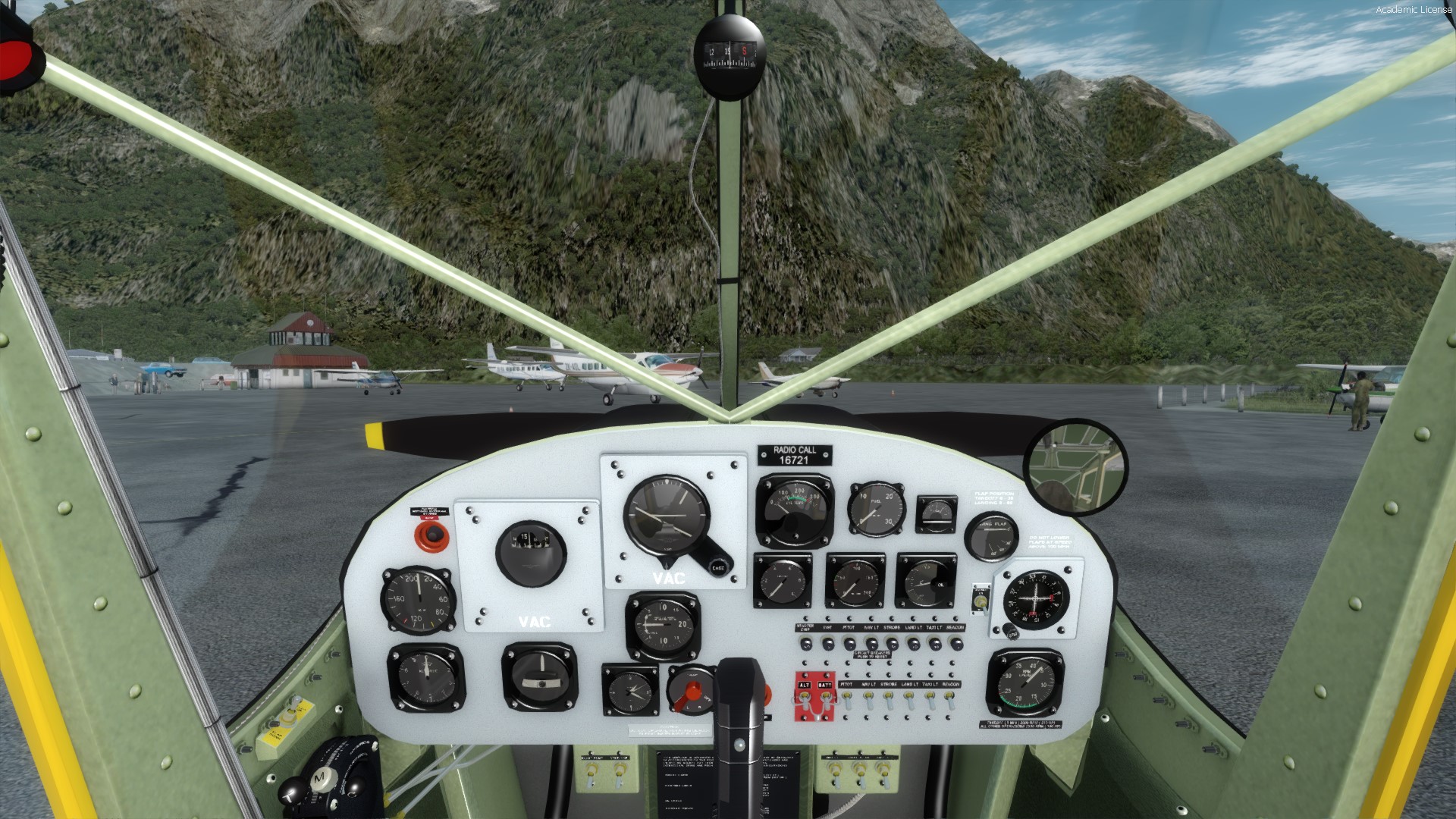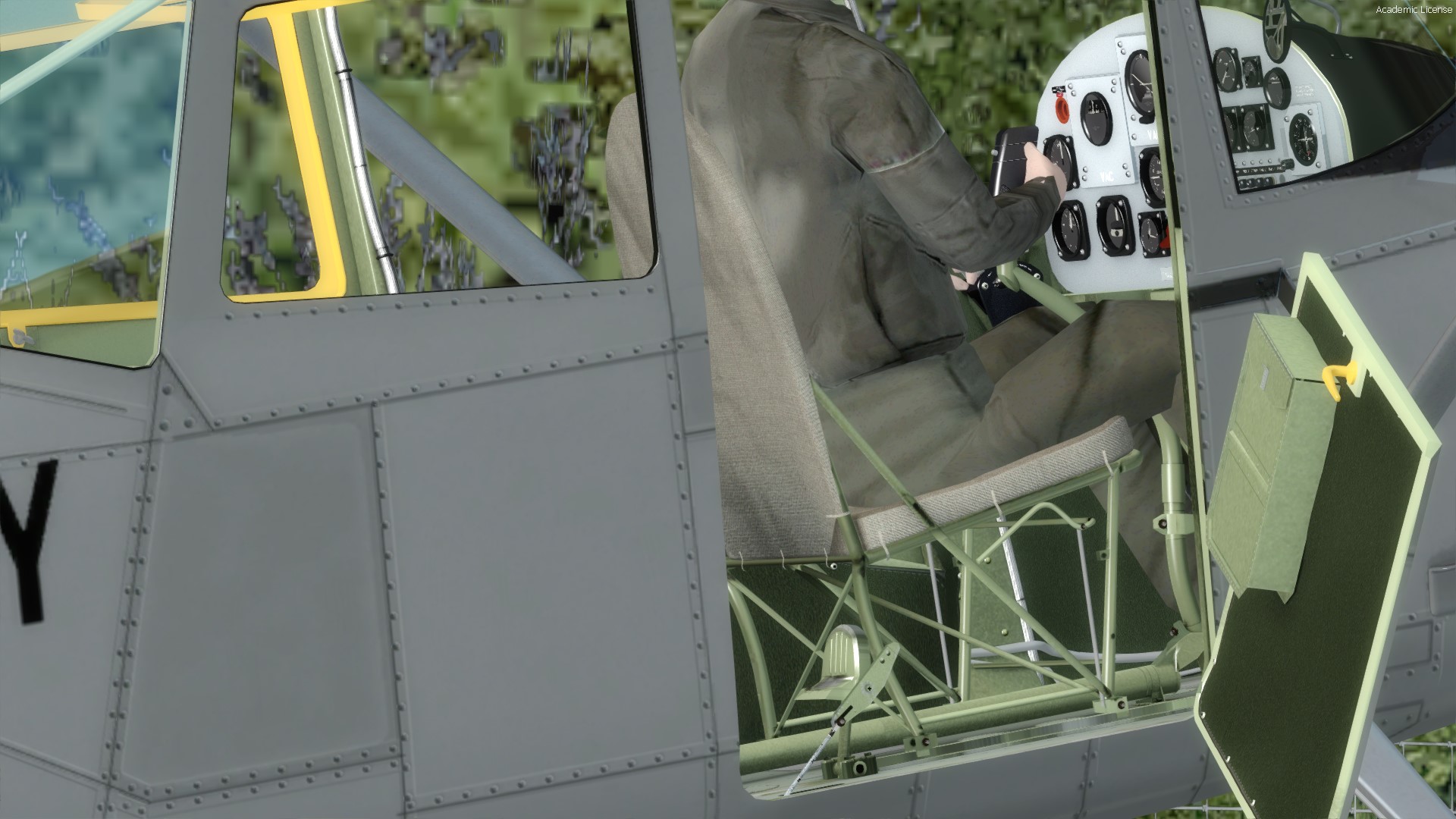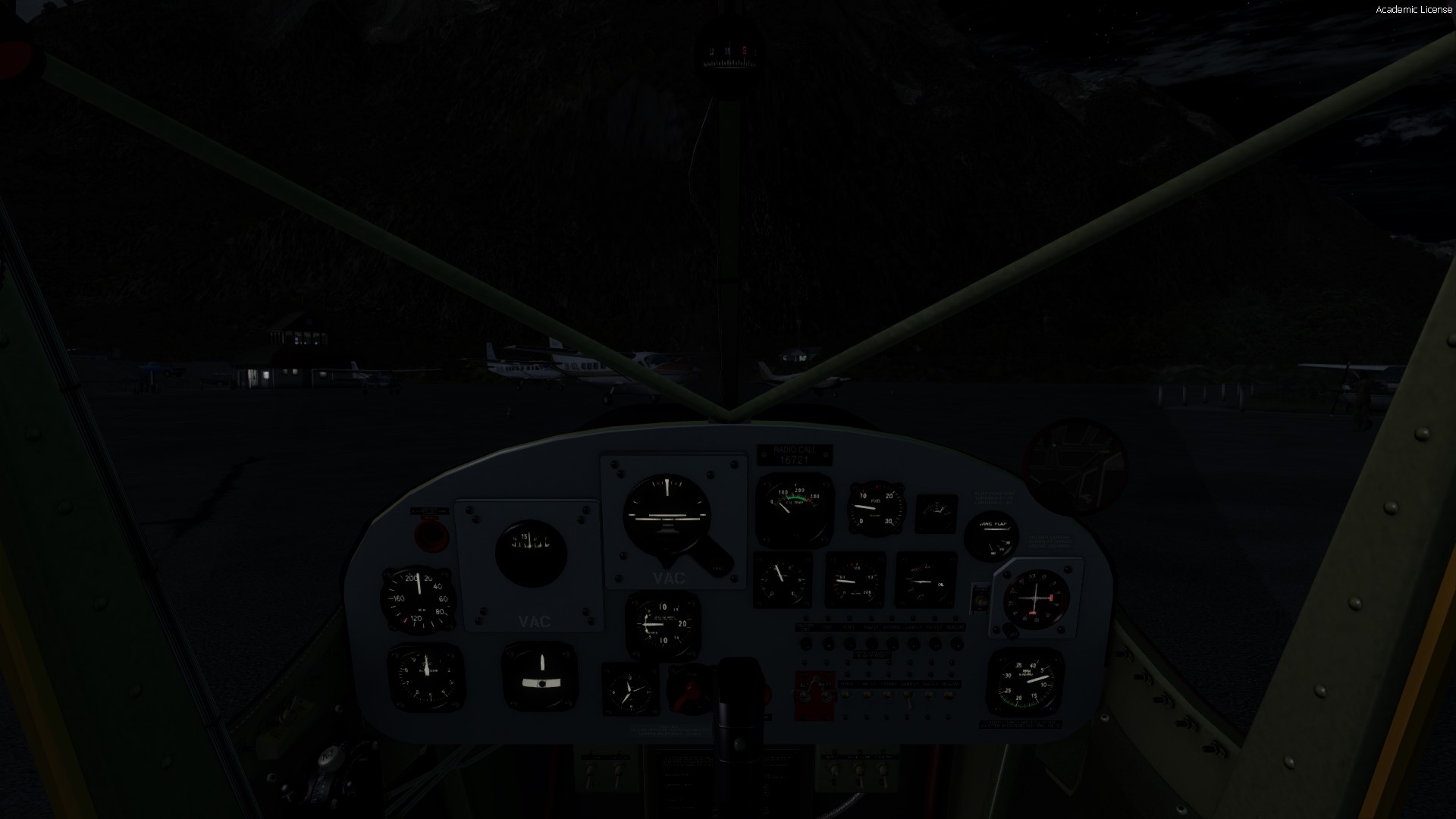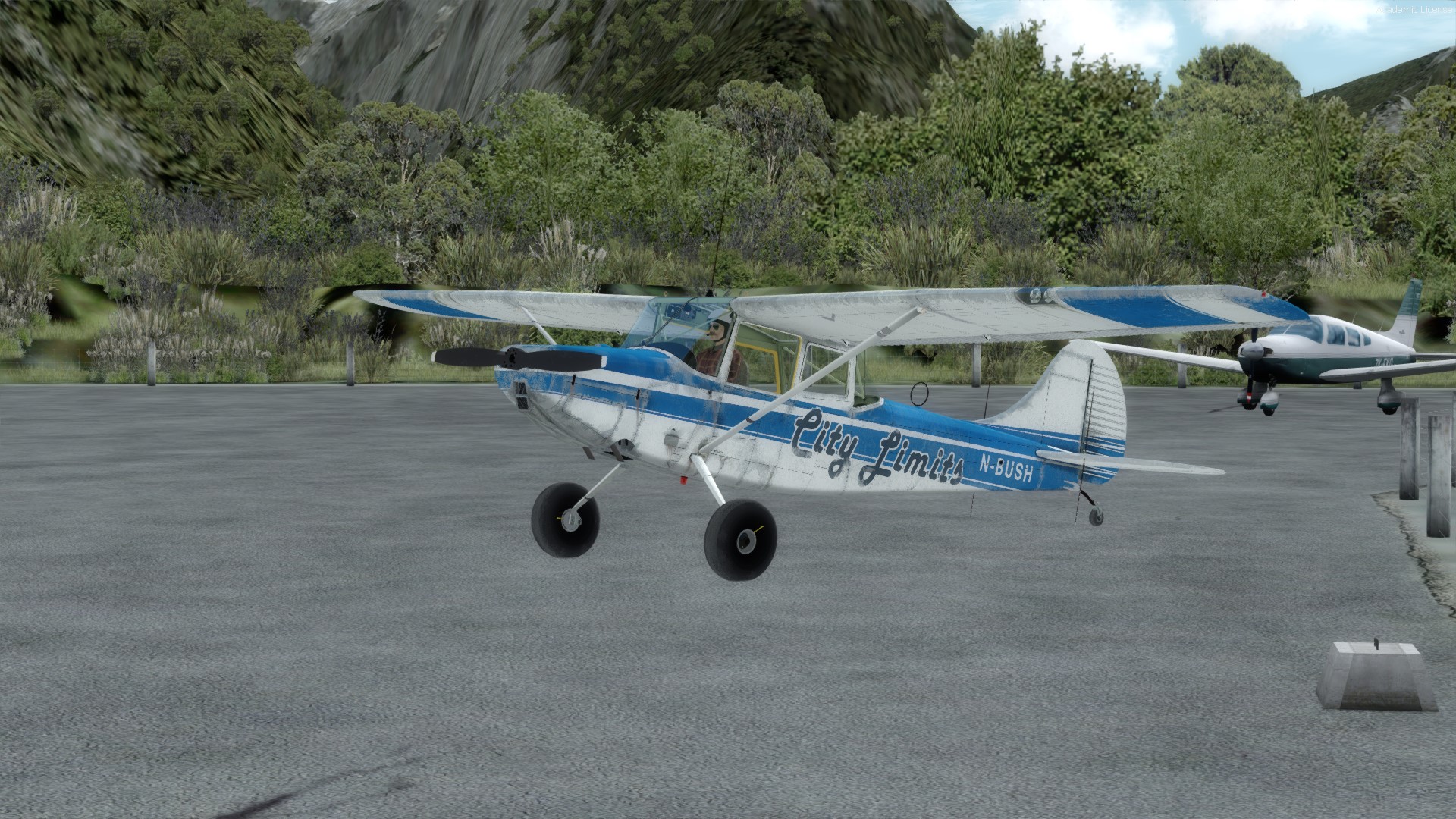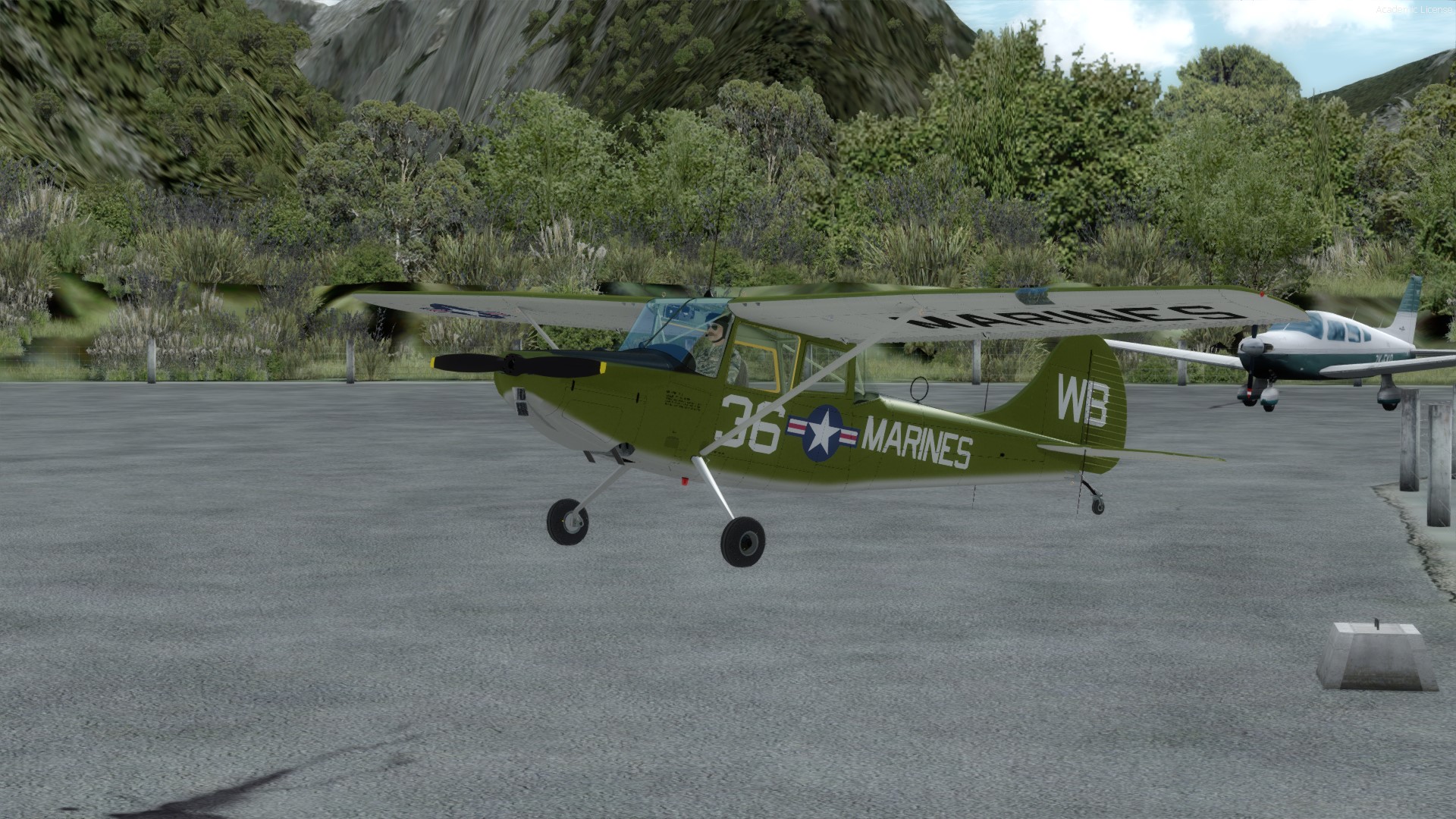Introduction
Whilst Cessna has an extensive history in the manufacture of civilian aircraft, their success in securing contracts for military requirements was a lot slower in comparison to their competitors. The Cessna T-50 Bobcat was the company's first major military contract, followed by the Cessna 195, albeit in very small numbers, with only a handful of other civilian models impressed into service during the early years of World War II. In the late 1940's, the United States Army was searching for a liaison and observation aircraft to replace various aircraft models used during World War II, and so the Cessna L-19 Bird Dog was born.
BlackBox Simulation have been producing a range of aircraft add-ons for over 15 years. Following on from the recent release of the Scottish Aviation Bulldog V2, they have now produced the Cessna L-19 Bird Dog. BlackBox Simulation's modelling of the L-19 Bird Dog beautifully captures the essence of this iconic aircraft so synonymous with the Korean and Vietnam Wars. An aircraft with fantastic handling characteristics, this marvellous aircraft has great historical appeal.
History
Originally designated the Cessna 305A, the L-19 Bird Dog is a tandem seat, lightweight, liaison and observation aircraft. It is a strut braced, high wing, monoplane design with a tailwheel landing gear and is powered by a Continental O-470-11, flat six, piston engine. Cessna developed the L-19 Bird Dog in response to a specification for a two seat liaison and observation monoplane issued by the United States Army to replace various aircraft models used during World War II. Due to the short service life experienced with fabric covered aircraft during the war, the Army specified that the aircraft was to preferably be constructed of all metal. Cessna developed the L-19 Bird Dog in a relatively short time by mating the wings and empennage of the Cessna 170 with a redesigned fuselage with a tandem seat configuration, angled side windows to improve ground observation, the rear fuselage providing a view directly to the rear, and transparent panels in the wing centre section over the cockpit. A wider door was also fitted to allow a stretcher to be loaded.
The prototype Cessna 305 first flew on 14 December 1949. The United States Army awarded an initial contract to Cessna for 418 aircraft, which was then designated the L-19A Bird Dog. Deliveries began in December 1950, and with the advent of the Korean War, the aircraft then saw service in Korea from 1950 through 1953 followed by extensive service in the Vietnam War where it was used extensively in a multitude of roles. The United States Department of Defense ultimately extended the order to approximately 3,200 L-19 Bird Dogs, across various model variants, for both the United States Army and United States Marine Corps, with variants also being converted for the United States Air Force
The L-19 Bird Dog was produced in or converted to a number of major variants:
L-19A (Cessna 305A) – initial and main production variant, redesignated OE-1, O-1A, and O-1B;
TL-19A – dual control trainer conversion of the L-19A, redesignated TO-1A;
TL-19D (Cessna 305B) – instrument trainer variant, with dual controls, redesignated TO-1D;
L-19E (Cessna 305C) – improved version of the L-19A with equipment changes and a higher gross weight, redesignated O-1E;
OE-2 (Cessna 321) – redesigned version of the L-19A with Cessna 180 wings and remodified fuselage, redesignated O-1C;
O-1D – Forward Air Controller conversion of the TO-1D (TL-19D) for the United States Air Force;
United States Air Force; and
O-1G (Cessna 305D) – Forward Air Controller conversion of the O1-A (L-19A) for the United States Air Force.
Over the course of production, the quantity ordered by the United States Department of Defense accounted for more than 93% of the total production numbers of the L-19 Bird Dog, and the aircraft was also produced for the military forces of a large number of other countries. Production ran from 1950 to 1959 with the total production reaching an impressive 3,431 aircraft.
Availability and Installation
The BlackBox Simulation Cessna L-19 Bird Dog is currently available direct from BlackBox Simulation as a download only product. It is normally priced at €15.99, or the equivalent on currency cross rates. The download file size is 188MB and it requires 2GB of HDD/SSD space for installation. The installation process is intuitive and requires you to connect to your BlackBox Simulation account to verify the registration code and activate the product. The installation process also installs the BlackBox Simulation PreFlight Manager application.
Model Features
The major model features of the Cessna L-19 Bird Dog include:
four models variants, standard, amphibian, bush, and float;highly detailed external model and virtual cockpit;
3D gauges;
accurately detailed parts, including separate red and white dome lights and instrument lighting;
animated antennae and exhaust pipes dynamically linked to engine vibration, airspeed, and G load;
chocks, remove before flight flags, and chain link tie downs;
dynamic reflection (P3D) and all surfaces bump mapped;
animated pilot, configurable with headset or helmet; and
custom sound set with special sounds.
PreFlight Manager
The PreFlight Manager application provides the ability to manage and configure various aspects of your BlackBox Simulation products. After installing a product, the "Settings" section of the PreFlight Manager provides the ability for the user to log in to their BlackBox Simulation account and register the product with the serial number provided at the time of purchase. Also under the "Settings" section is the ability to set "Default Weights" and "Default Units Of Measure". Here in lies the first problem with this application, and a problem which continues to exist from earlier product releases, as the "Default Weights" fields are restricted to a range of weights which are restrictive and / or irrelevant to the L-19 Bird Dog. According to the default weight settings, the "Flight Crew" cannot weigh any more than 220.462 lbs. So, it is too bad if you are a solidly built 6' 4" pilot weighing 285 lbs. The "Fleet Management" section displays the installed products and respective liveries and provides the ability to individually uninstall liveries. The "Payload" section provides the ability to set various aspects relating to the aircraft's configuration, pax, cargo, and fuel. As some of this information is populated from the defaults in the "Settings" it can be unrealistic or restrictive in the range of figures used. The remaining section is "Dispatch", but this section does not support the L-19 Bird Dog. A final aspect about the PreFlight Manager is that it is installed to a default location under C:\Program Files (x86) with no option to install it to an alternative location.
Visual Appearance
General Overview and Exterior. The Cessna L-19 Bird Dog presents as the typical observation aircraft with excellent all round vision afforded by the angled side windows, rear windows, and the transparent centre roof section panels. As you would expect, it is a simple aircraft, with the tandem seat arrangement and slender airframe giving it a close, if not claustrophobic appearance. The high quality of the external model is very good, exhibiting an excellent level of detail, right down to the various antennae arrangements. BlackBox Simulation have done an wonderful job on the external modelling of the L-19 Bird Dog and it beautifully captures the design of this quintessential observation aircraft. Note. BlackBox Simulation claim on their web site and in the Aircraft Operating Manual that the model represents the L-19C variant. However, after extensive research, no variant with this specific designation and no reference to such a production variant could be found. The closest variants to such a designation are the O-1C, which is actually the Cessna 321 and is a redesigned version of the L-19A with Cessna 180 wings and a remodified fuselage, or the Cessna 305C (L-19E), which had a higher gross weight than that represented in the modelled aircraft.
Flight Instruments, Avionics, and Aircraft Systems. Typical of its military purpose and the era, the L-19 Bird Dog is faithfully reproduced with an all analogue panel. The narrow fuselage design means the various radios and fuel switches are mounted in the top corners on either side of the airframe. Other than your primary flight instruments, there is a single VHF NAV radio, directional radio, and associated gauges. In particular, the directional radio replicates the type from the era and is quite different in its operation. Once familiar with it though, it becomes a natural process, albeit, you have look to the radio in the top right corner for directional guidance.
Animations, Lighting, and Sounds. The Cessna L-19 Bird Dog includes the typical range of animations you would expect for such an aircraft. A wonderful touch to the animations is the animated vibration of the antennae and engine exhaust pipes. In addition, the static elements of the cover, wheel chocks, tie down, and remove before flight flags are a nice touch. It also includes a dog food bowl, befitting its Bird Dog name – maybe this can be used as an oil drip tray. The lighting is basic, but so is the aircraft, so it is reasonable for the model as it is and the red light provides the typical soft glow associated with this light condition. The engine sound is also a reasonable representation of what you would expect from the Continental O-470 engine, with a deep throaty rumble at idle, and it provides very good stereo separation in both the internal and external views.
Models and Liveries. The BlackBox Simulation Cessna L-19 Bird Dog is provided in four model choices, standard, amphibian, bush, and float, with a total of 11 liveries (a selection showing below). Displaying high quality, the surface textures, reflections, and shadings, give each aircraft an excellent appearance. However, in general, there is a total lack (with the exception one specific livery) of any kind of scrape and scuff marks, dirt, exhaust, oil, or grease stains, which give this aircraft a very unnatural, pristine look.
Issues. There were a number of issues uncovered in the BlackBox Simulation Cessna L-19 Bird Dog which collectively served to create a disappointing impression. A major disappointing factor with the cockpit panel was the visual polygon appearance on all circular gauges and the curved top of the panel. There was also an anomaly with the airspeed indicator in that the manual states it is calibrated in miles per hour, typical of aircraft of this era, yet it is actually calibrated in knots indicated airspeed (KIAS). All reference speeds in the manual are also in miles per hour, so be prepared to be further confused. On a less conspicuous issue, both the main and auxiliary fuel gauges are missing a graduation between the 15 and 20 graduation marks. Moving onto the flap operation, and here it gets really confusing because the manual contradicts itself multiple times and it is not entirely clear which parts of the manual exactly pertain to the flap operation modelled in the aircraft. The manual indicates there are five flap settings with the flap position being "...ascertained by looking at the markings on the rear cockpit window frame...". Now, ignoring that a flap indicator gauge is provided, noting that it is missing the first two setting indications, the markings on the rear cockpit frame do not exist. So, let's go back to the flap operation then, five flap settings - FAIL, only three position settings. At least the flap position settings were consistent with the indicator marks on the flap indicator gauge and that indicated in at least one part of the manual on flap operation. Notwithstanding that though, the manual also states about the flap positions that the "...flaps can be selected at these settings or any setting in between..." and details how, through the use of the wing flap switch, this is done – FAIL again, still only three position settings. Moving on! The parking brake for the aircraft is set by way of a control lock which is secured to the control stick (as indicated in the manual). However, when in place, the control stick can still be moved through its full range of movement as the locking pin (indicated in the manual) on the control stick is non existent – at least the parking brake works. Furthermore, a major external visual issue was observed with the contact points for the wheels on the amphibian and bush variant. In both cases, the contact points are set too low, giving the tyres the appearance of being very flat / underground. Finally, to cap it off, and before I get carried away any further, the external cockpit door latch handle also does not exist – so good luck trying to get into the cockpit. As the age old idiom goes, "Looking the part is half the battle!", and when such fundamental issues as the airspeed indicator calibration, flap position operation, and wheel contact points are overlooked it detracts from the quality disproportionately, particularly when they are such simple errors. The confusing aspect as to which aircraft variant is actually modelled also undermines a certain level of confidence in the overall quality of the model. An aircraft paint kit is also allegedly planned for painting enthusiasts, however, it has been some months since the L-19 Bird Dog was released and the paint kit is still not available.
Summary and Variations. Notwithstanding the identified issues, the rendition of the BlackBox Simulation Cessna L-19 Bird Dog is beautifully detailed and the visual quality is excellent. The modelling provides a marvellous representation of the real world aircraft. Most major elements of the cockpit are clear and easy to read, albeit that some gauges lack clarity unless viewed at high zoom levels, otherwise, the texture quality was good. There was a lack of alternative cockpit views which could have assisted in viewing the smaller gauges. Nonetheless, any other noted visual variations were minor and are considered to be related to real world production variations or a degree of artistic licence on the part of the developer. Any noted issues and variations with cockpit functions and operation were considered minor and / or in the interests of simplifying the function for practical flight simulator use.
General Characteristics and Performance Specifications
The general characteristics and performance specifications for the Cessna L-19 Bird Dog are provided in the table. This is based on data from the Cessna L-19 Bird Dog Aircraft Operating Manual, data provided by BlackBox Simulation, and general research sources. Some of this data varies between sources and also may be an approximation due to variances in data and the specific aircraft modelled by BlackBox Simulation.
General Characteristics
| Crew | One |
| Passenger Capacity | One |
| Length | 25 ft 10 in (7.88 m) |
| Wingspan | 36 ft 0 in (10.97 m) |
| Height | 7 ft 4 in (2.23 m) |
| Empty Weight | 1,614 lb (734 kg) |
| Fuel Capacity | 41.0 US gal (155.2 l) |
| Maximum Take-Off Weight (MTOW) | 2,400 lb (1,089 kg) |
| Power Plant | 1 x Continental O-470-11, six cylinder, horizontally opposed, air cooled, piston engine, 213 hp (159 kW) |
Performance Specifications
| Maximum Speed | 100 kts (115 mph, 185 km/h) |
| Cruise Speed | 87 kts (104 mph, 167 km/h) |
| Stall Speed | 47 kts (54 mph, 87 km/h) full flaps, engine at idle |
| Range | 460 nm (530 mi, 853 km) |
| Service Ceiling | 18,500 ft (5,640 m) |
| Rate of Climb | 1,150 ft/min (351 m/min) |
Flight Performance
A specific Test Flight was conducted to test the flight performance of BlackBox Simulation's Cessna L-19 Bird Dog. The flight was conducted in clear weather with a full fuel load. A cruise altitude of 5,000 ft was adopted and the route distance was particularly chosen to provide a basis upon which to test the range characteristics of the aircraft.
The aircraft is very easy to taxi and visibility, for a tailwheel aircraft, was good. With a flaps setting of 0° (because I cannot set them to 10°, as specified in the manual), and the elevator trim set to the take-off position, aircraft rotation occurred at approximately 50 KIAS with a rate of climb on climb out consistent for the performance specifications for the aircraft. Alternatively, if left to its own devices, with no back pressure on the control stick, the L-19 Bird Dog will eventually lift off the runway, gently and gracefully. The L-19 Bird Dog has excellent short field capabilities and with a flaps setting of 30°, aircraft rotation occurred within a distance comparative to the short field take-off performance specifications for the aircraft. As expected, the Cessna L-19 Bird Dog is extremely nimble and agile, befitting the role for which it was designed, and it responds nicely to control inputs. Applying typical cruise settings for the aircraft, the L-19 Bird Dog trims out and cruises beautifully at approximately 85 KIAS. The Test Flight confirms the modelling of the aircraft for speed performance to be what would reasonably be expected of this aircraft.
Configured for a normal landing, with a flaps setting of 40°, and trimmed for a rate of descent of approximately 500 ft/min, the aircraft's approach speed was approximately 60 KIAS and it touched down at approximately 50 KIAS, with a landing roll-out comparable with the specifications for the aircraft.
In testing the accuracy of the instruments, based on the measured Test Flight, the speed indications on the airspeed indicator, were consistent with the averages measured. Additionally, when establishing a set rate of climb on the vertical speed indicator, the respective gain in altitude on the altimeter was achieved within the measured minute, and a standard rate turn was achieved within the measured two minute period using the turn coordinator.
The performance of the BlackBox Simulation Cessna L-19 Bird Dog was excellent in flight, displaying the expected general flight characteristics of this aircraft. It is responsive to control inputs and is also very steady once trimmed for level flight or established on approach. Overall, the aircraft model displays an excellent rendition of the flight characteristics and performance expected of this type of aircraft. The aircraft handles beautifully and is a delight to fly.
Documentation
Two manuals are provided in Adobe Acrobat format (.pdf) for the BlackBox Simulation Cessna L-19 Bird Dog:
Cessna L-19 Bird Dog Aircraft Operating Manual, 111 pages; and
BlackBox Simulation Product Setup Guide, three pages.
The manual is professionally produced and can be described as a hybrid of real world documentation and an operation manual for the aircraft modelled by BlackBox Simulation. As such, it contains a wealth of technical information and is informative, in part, to the operation of the aircraft modelled. However, at 111 pages, and in a format which does not clearly differentiate between that which pertains to the real world aircraft's operation and the operations modelled on the aircraft, it is next to useless. This was clearly evident in trying to decipher how the exact operation of the flaps was modelled. By all means, reproduce the real world information for those who will soak it up, but it does little for the common flight simmer who just wants to fly their new acquisition, an acquisition which, in this case, is very basic when it comes to its operation in a flight sim. This information needs to be segregated into two separate manuals. In a nutshell, there is some quality information which pertains to the L-19 Bird Dog's operation in the flight sim somewhere in those 111 pages, however, in its current format, fundamentally, the manual leaves a lot to be desired!
Value for Money
The BlackBox Simulation Cessna L-19 Bird Dog is a simple aircraft add-on and is priced appropriately. At €15.99, the Value for Money for the BlackBox Simulation Cessna L-19 Bird Dog is considered excellent.
Simulator Performance
The aircraft model performed excellently within the existing settings I have in P3D. I have most of my settings set very high and there was no need to make any adjustments. There was no discernible frame rate impact directly attributable to the BlackBox Simulation Cessna L-19 Bird Dog and P3D continued to perform smoothly.
Technical Requirements
This version of the BlackBox Simulation Cessna L-19 Bird Dog is for FSX / FSX SE / P3D only. Other specified technical requirements are as follows:
Windows 10 / 8 / 7 / Vista (32bit or 64bit);
FSX with SP2 installed (or Acceleration Pack), FSX Steam Edition, or Prepar3D (v2 / v3 / v4); and
3.0GHz CPU, 2GB RAM, 512MB graphics card, and 2GB available HDD space.
Review Computer Specifications
The specifications of the computer on which the review was conducted are as follows:
Intel i7 990X Extreme 3.46GHz;
NVidia GTX980 G1 Gaming, 4GB, 1228/1329MHz;
12GB, Kingston DDR3, 2000MHz, XMP T1 CL9 HyperX;
Windows 7, (64bit); and
Lockheed Martin P3D Version 3.4.22.19868.
Additional Major Add-ons.Active Sky 2016, Active Sky Cloud Art, FS Global Ultimate region series, Orbx FTX Global BASE, Orbx FTX Global VECTOR, Orbx FTX Global openLC series, Orbx FTX region series, Orbx FTX airport series, and Orbx FTX Trees HD.
Conclusion
The BlackBox Simulation Cessna L-19 Bird Dog beautifully captures the simple lines of this excellent aircraft. A brilliant military observation aircraft and an icon of the Korean and Vietnam Wars, BlackBox Simulation's model is faithful to the real world aircraft. The observed issues (and possibly the ones not detected because I had to stop myself going any further) were disappointing and detract from a product that has the potential to be better. Oversights on obvious errors are just not acceptable as customers expect (often demand) better. The format of the manual needs work and could go a long way to improving clarity and understanding on the actual operation of the aircraft in the flight sim. Add in the confusion factor over which L-19 Bird Dog variant is modelled and it just goes to creating further doubt about the overall quality of the product. Given the identified issues, the quality of the beta testing (if it existed at all) and what was it that was actually tested has to be questioned. Notwithstanding these issues, the Cessna L-19 Bird Dog is a delight to fly, exhibiting the fantastic handling characteristics you would expect from this military observation aircraft. Nicely priced, the BlackBox Simulation Cessna L-19 Bird Dog will still provide much enjoyment.
Verdict and Scores
Verdict
| Putting the identified issues aside, the BlackBox Simulation Cessna L-19 Bird Dog is a beautiful aircraft add-on product and one which will appeal greatly to flight simmers who enjoy flying military aircraft. |
Scores
For |
Against |
Category |
Score/10 |
|---|---|---|---|
| High quality textures. | Visible polygon on round cockpit gauges. | External Model | 9.0 |
| Very good exterior modelling. | Modelling errors. | Internal Model | 8.0 |
| Fantastic flight characteristics. | Inconsistencies between the manual and aircraft operation. | Sounds | 9.0 |
| Excellent Value for Money. | Lack of alternative cockpit views. | Flight Characteristics (does it fly by the numbers) | 9.0 |
| Documentation format needs significant improvement. | Flight Dynamics (does it feel like what it looks like) | 9.5 | |
| Documentation | 7.0 | ||
| Value for Money | 9.5 |
Overall Score

The BlackBox Simulation Cessna L-19 Bird Dog is awarded an overall Mutley's Hangar score of 8.7/10, |




